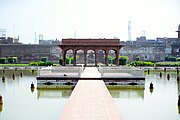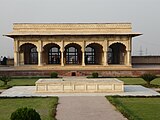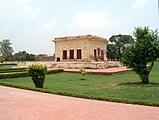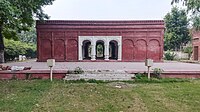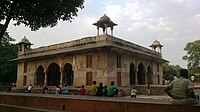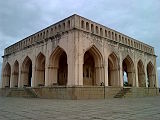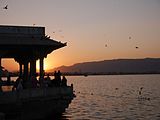Baradari (building)
Baradari, also Bara Dari, is a building or pavilion with twelve doors designed to allow free flow of air. The structure has three doorways on every side of the square-shaped structure.

Because of their outstanding acoustic features, these buildings were particularly well-suited for mujra dance or courtesan dance performances by the noble courtesans. They were also well-suited for live performances and private concerts by various musicians and poets in front of the ruling kings of the time. They were also valued for their fresh air during hot summers of India. Bara in Urdu/Hindi means Twelve and the word Dar means 'door'.
Baradaris
[edit]Some of the historic baradaris are Lucknow Baradari, Taramati Baradari,[1] Hazuri Bagh Baradari,[2] Baradari at Daulatabad Fort near Aurangabad, Maharashtra, Goshamal Baradari, Baradari at Palace of Man Singh I at Amber Fort Jaipur, etc.
Gallery
[edit]-
Baradari at Mansingh Mahal, Amber Fort, Jaipur
-
Heera Mahal Baradari, Red Fort, Delhi
-
Baradari at Shalimar Gardens, Lahore
-
Lahore Fort Baradari
-
Baradari at Hiran Minar, Sheikhupura, Pakistan
-
Baradari at Umaid Bhawan Palace, Jodhpur
-
Baradari at Shalimar Gardens First Level, Lahore
-
Baradari in Sherawala Garden, Gujranwala
-
Baradari at Roshanara Bagh, Delhi
-
Taramati Baradari, Hyderabad
-
Wazir Khan's Baradari, Lahore
-
Baradari Inner View at Sherawala Garden, Gujranwala
-
Baradari of the Golconda Fort
-
Baradari at Katasraj Mandir, Choa Saidanshah Chakwal District of Punjab in Pakistan
References
[edit]- ^ "Cultural Hamlet". The Hindu. 27 January 2004. Archived from the original on 15 February 2004. Retrieved 28 February 2017.
- ^ a b http://lahore.city-history.com/places/hazori-bagh/ Archived 2019-04-21 at the Wayback Machine, Hazuri Bagh Baradari, Lahore on History of Lahore website, Retrieved 28 February 2017


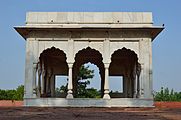
![Hazuri Bagh Baradari, Hazuri Bagh, Lahore[2]](http://upload.wikimedia.org/wikipedia/commons/thumb/9/90/Hazuri_Bagh_Baradari_infront_of_Roshnai_Gate.JPG/181px-Hazuri_Bagh_Baradari_infront_of_Roshnai_Gate.JPG)
